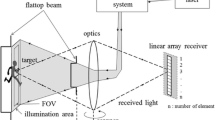Abstract
Laser ranging is a crucial issue for collimation zoom optical systems, in order to make sure the beam alignment adapt to the aperture, the spatial divergence angle of the laser beam should be improved. In this paper, a collimation zoom optical system was designed based on the principle of non-focal magnification collimation and direct beam expansion. The optimized operation function DMVA is input into the Zemax simulation system to control the image height, and the curvature, thickness and air space of each lens of the system are optimized to reach the index requirements. The results of the optical track simulation shows that the energy distribution is uniform and non-dispersive. The collimation zoom system, four-group telescope is used instead of the group telescope structure, which have simple structure, the design of cam curve ensure the boresight of optical axes meets the design index, that reduce the ranging error efficiently. The accuracy error of the instrument is less then 0.5 m when field ranging is 10 km.








Similar content being viewed by others
References
Shi, G., Zhang, F., Qu, X., & Meng, X. (2014). Absolute distance measurement by high resolution frequency modulated continuous wave laser. Acta Physica Sinica, 63(18), 184209.
Zhang, T., Dong, N., Zhang, Y., & Guo, J. (2017). Phase-shift measurement based on I/Q demodulation for laser ranging. Optics & Optoelectronic Technology, 15(03), 6–10.
Yu, T., Wang, C., Tang, X., & Liu, Y. (2016). Design of two-dimensional zoom beam expender optical system based on ZEMAX. Laser & Infrared, 46(06), 747–751.
Liu, H., An, Z., et al. (2010). A laser zoom expansion beam optical system design. Journal of Changchun University of Science and Technology, 33(4), 19–20.
Mu, S., Song, J., Li, Y., & Jiao, W. (2016). Spaceborne laser range finder beam expansion system with high precision mounting. Infrared and Laser Engineering, 45(03), 123–127.
Zhao, Y., Song, F., & Sun, H. (2007). Design of expanded beam emission optical system with 1.06 μm pulsed laser high—Magnification zoom. Infrared and Laser Engineering, 06, 891–895.
Lin, L., Chen, Z., Lan, F., Wang, X., Deng, K., Lv, J., et al. (2017). Design and fabrication of convex lens automatic focusing platform based on expanded beam—Collimator. Journal of Longyan University, 35(02), 70–73.
Wu, T. (2016). Research on long distance beam collimation and dynamic measurement and control technology of laser tracker. Harbin Institute of Technology. http://www.cnki.net/.
Acknowledgements
The project was supported by institute of China ordnance industries support technology project (Grant No. 62201040504-A).
Author information
Authors and Affiliations
Corresponding author
Rights and permissions
About this article
Cite this article
Zhang, M., Tang, C., Xiang, Y. et al. Simulation Design of Collimation Zoom Optical System Based on Laser Ranging. Wireless Pers Commun 102, 2455–2467 (2018). https://doi.org/10.1007/s11277-018-5265-9
Published:
Issue Date:
DOI: https://doi.org/10.1007/s11277-018-5265-9




